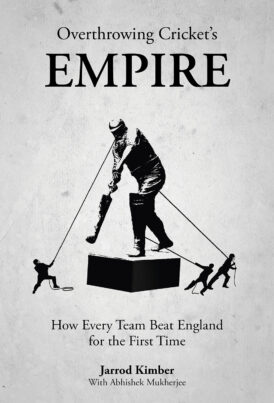Overthrowing Cricket’s Empire
Martin Chandler |Published: 2024
Pages: 256
Author: Kimber, Jarrod and Mukherjee, Abhishek
Publisher: Pitch
Rating: 3.5 stars

It has taken me a few years to get used to Jarrod Kimber’s writing, but having got there I’m glad I persevered. He has undoubtedly pioneered a more combative style than I had been used to, but one I now realise is entirely appropriate to the 21st century.
How every team beat England for the first time is the subtitle of this one, which is a decent idea. The dust jacket is an interesting one, the image of a statue of WG Grace being attacked in the manner of that of Bristol slave trader Edward Colston in 2020 made we wonder just what I was going to read, although with that thought it turned out that my imagination was running away with itself.
In the event, as is often the case, that sub-title does tell you what you need to know. There is an obvious interest for all cricketing countries in celebrating their first victory over England, but at the same time by definition those are matches that have already been written about and celebrated at some length, so to turn the subject into a book that will attract a decent level of sales is a challenge.
But then that sub-title is not always strictly accurate. The ‘main event’ in the chapter on Australia, for example, does not concern itself in any detail with the inaugural Test but, as the jacket suggests it might, concentrates primarily on two fixtures involving WG Grace. The first of those, MCC v Australia on the 1878 tour (when no actual Tests were played) was famously all over in a day the home side being rolled over for 33 and 19, making the 41 Australia managed in their first dig sufficient to enable the visitors to cruise to a nine wicket win. The second was a Test, that at the Oval two years later when ‘The Ashes’ legend was born.
As for India they first beat England as long ago as the winter of 1951/52, and they won again at home in 1961/62, but whilst those victories are mentioned the bulk of the chapter is, entirely reasonably, devoted to the famous victory at the Oval in 1971 when India beat a truly representative England side for the first time.
So perhaps the key is the first victory over England in England, but no. The South African chapter concentrates on the ‘googly summer’ of 1905/06, and that concerned with the West Indies on the successes in the Caribbean between the wars rather than the Calypso English summer of 1950 when with their batting led by the “Three W’s” and the bowling by “Ram and Val” the visitors did not merely beat England but swept them aside.
The good news is that the individual chapters are not simply a rehashing of ancient history. The accounts are largely written from the perspective of the individuals concerned. Kimber acknowledges that much research has been done by Abhishek Mukherjee, but then as anyone who has read any quantity of Kimber’s previous writings know he himself is a man who is no stranger to the game’s ancient history, even if his distinct and idiosyncratic style is in no way reminiscent of that of the likes of Cardus, Arlott and Robertson-Glasgow.
One chapter that is as expected is that on Pakistan who, alone amongst England’s opponents, won a Test on their first visit here, back in 1954. It is a wonderful story, one of my absolute favourites, and Kimber does it full justice. He also deals very well with New Zealand, whose first victory over England I remember well. But then Kimber doesn’t bother with that. The chapter on the New Zealanders goes back to 1949 when Walter Hadlee’s collection of part time cricketers drew each of their four Tests, and lost only once all tour.
So the first chapter that brought back personal memories was Sri Lanka, and Murali’s 16 wickets in a ten wicket win at the Oval. The account of that match is prefaced by a brief look at the Lankans introduction to international cricket, and that sort of approach is what characterises the remaining chapters, those dealing with the nations who have beaten England only in ODIs.
Personally whilst I am as happy as the next man to watch the game’s shorter formats, at international level at least, such games almost never stick in my memory. For that reason in many ways I found the reminders of defeats by Zimbabwe, Netherlands, Scotland, Ireland, Bangladesh and Afghanistan and their back stories to be the most interesting in the book, and in particular that on Bangladesh, an account that reminds me that a full history of the game in that country is long overdue.
And then there is a seemingly random chapter, sandwiched between Bangladesh and Scotland, on the subject of England Women. I have spent a little time trying to work out just why the chapter features at all, and believe I have worked out the answer, although I will say nothing more in case I have reached the wrong conclusion on that. In a sense the rationale for its presence matters little, as it is certainly an entertaining and thought provoking digression.






Leave a comment